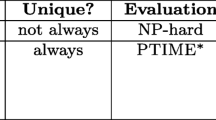Abstract
In this paper we study the computational power of polynomialtime query learning systems for several query types, and the computational complexity of a “learning problem” for several representation classes. As corollaries of our results, we prove some polynomial-time nonlearnability results, and relate polynomial-time learnability of some representation classes to the complexity of representation finding problems of P/poly oracles. For example, forCIR, a representation class by logical circuits, it is shown that P(NP ()1 ) is an upper bound of power of query learning systems forCIR, and that P(NP ()1 ) is also a lower bounds of power of query learning systems forCIR when they are used to learn a certain subclassR ofCIR. It is also shown that the problem of learningCIR is P(NP(NP ()1 ))-solvable. Then, using these results, the following relations are proved: (1) If, for someA ε P/poly, the representation finding problem ofA is not in P(NP A1 ), thenCIR is not polynomial-time query learnable even by using queries such as membership, equivalence, subset, superset, etc. (2) On the other hand, if the above-mentioned subclassR ofCIR is not polynomial-time query learnable by using subset and superset queries, then some Bε P/poly exists such that its representation finding problem is not in P(NP B1 ).
Similar content being viewed by others
References
D. Angluin, Queries and concept learning,Machine Learning 2 (1988), 319–342.
D. Angluin, Negative results for equivalence queries,Machine Learning 5 (1990), 121–150.
D. Angluin and M. Kharitonov, When won't membership queries help?,Proc. 23rd Annual ACM Symposium on Theory of Computing, ACM, New York (1991), pp. 444–454.
J. Balcázar, J. Diaz, and J. Gabarró,Structural Complexity, Vol. I, EATCS Monographs on Theoretical Computer Science, Springer-Verlag, Berlin (1988).
R. Gavaldà, Bounding the complexity of advice functions,Proc. 7th Structure in Complexity Theory Conference, IEEE, New York (1992), pp. 249–254.
R. Gavaldà and O. Watanabe, On the computational complexity of small descriptions,Proc. 6th Structure in Complexity Theory Conference, IEEE, New York (1991), pp. 89–101.
O. Goldreich, S. Goldwasser, and S. Micali, How to construct random functions,J. Assoc. Comput. Mach. 33 (1986), 792–807.
R. Karp and R. Lipton, Some connections between nonuniform and uniform complexity classes,Proc. 12th Annual ACM Symposium on Theory of Computing, ACM, New York (1980), pp. 302–309.
M. Kearns and L. Valiant, Cryptographic limitations on learning Boolean formulae and finite automata,Proc. 21st Annula ACM Symposium on Theory of Computing, ACM, New York (1989), pp. 433–444.
L. Pitt and M. Warmuth, Prediction preserving reducibility,J. Comput. System Sci. 41 (1990), 430–467.
U. Schöning,Complexity and Structure, Lecture Notes in Computer Science, Vol. 211, Springer-Verlag, Berlin (1985).
L. Stockmeyer, The polynomial-time hierarchy,Theoret. Comput. Sci. 3 (1977), 1–22.
L. Valiant, A theory of the learnable,Comm. ACM 27 (1984), 1134–1142.
M. Warmuth, Towards representation independence in PAC-learning,Proc. AII-89 Workshop on Analogical and Inductive inference, lecture Notes in Artificial Intelligence, Vol. 397, Springer-Verlag, Berlin (1989), pp. 78–103.
O. Watanabe, A formula study of learning via queries,Proc. 17th International Colloquium on Automata, Languages and Programming, Lecture notes in Computer Science, Vol. 443, Springer-Verlag, Berlin (1990), pp. 137–152.
O. Watanabe, A framework for polynomial-time query learnability,Math. Systems Theory, this issue, 211–229.
Author information
Authors and Affiliations
Rights and permissions
About this article
Cite this article
Watanabe, O., Gavaldà, R. Structural analysis of polynomial-time query learnability. Math. Systems Theory 27, 231–256 (1994). https://doi.org/10.1007/BF01578844
Received:
Revised:
Issue Date:
DOI: https://doi.org/10.1007/BF01578844




